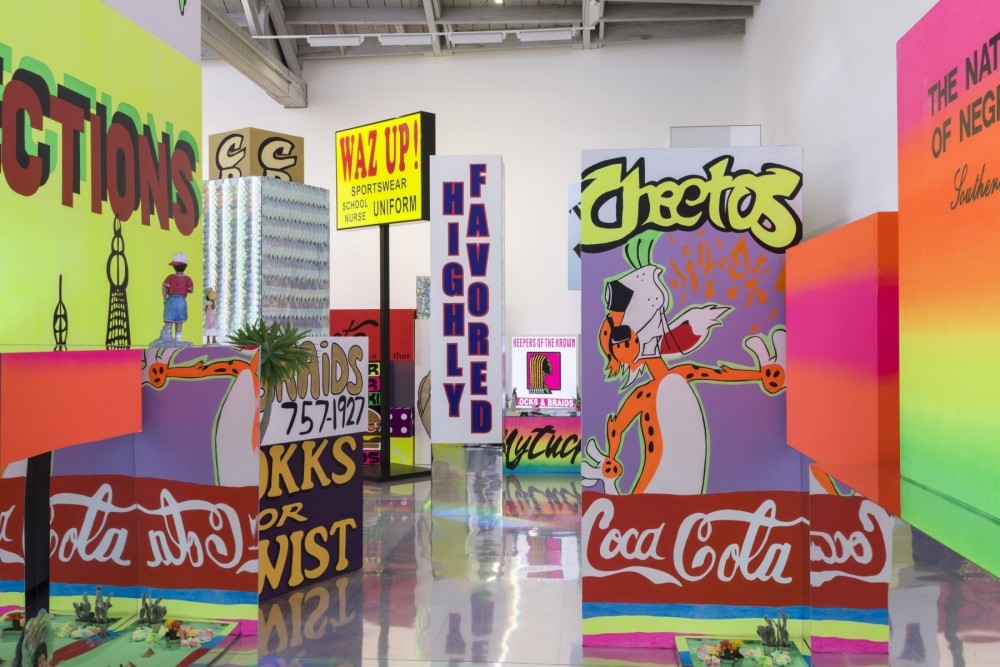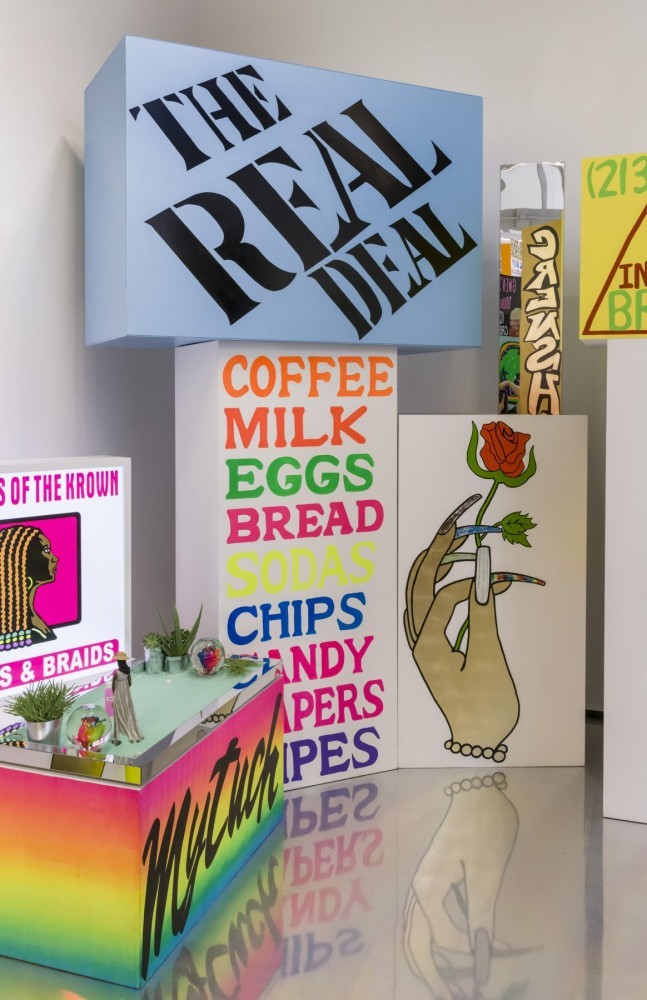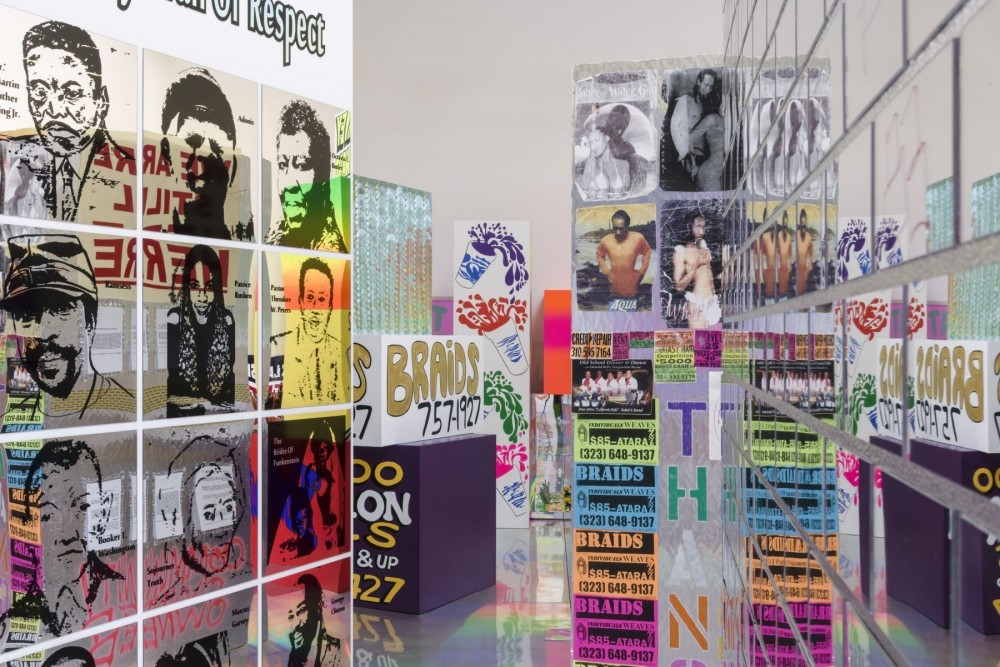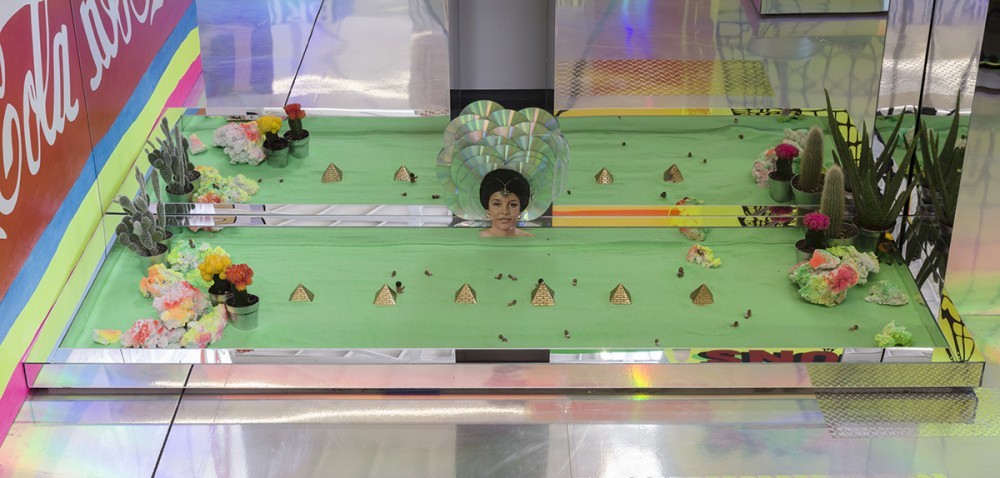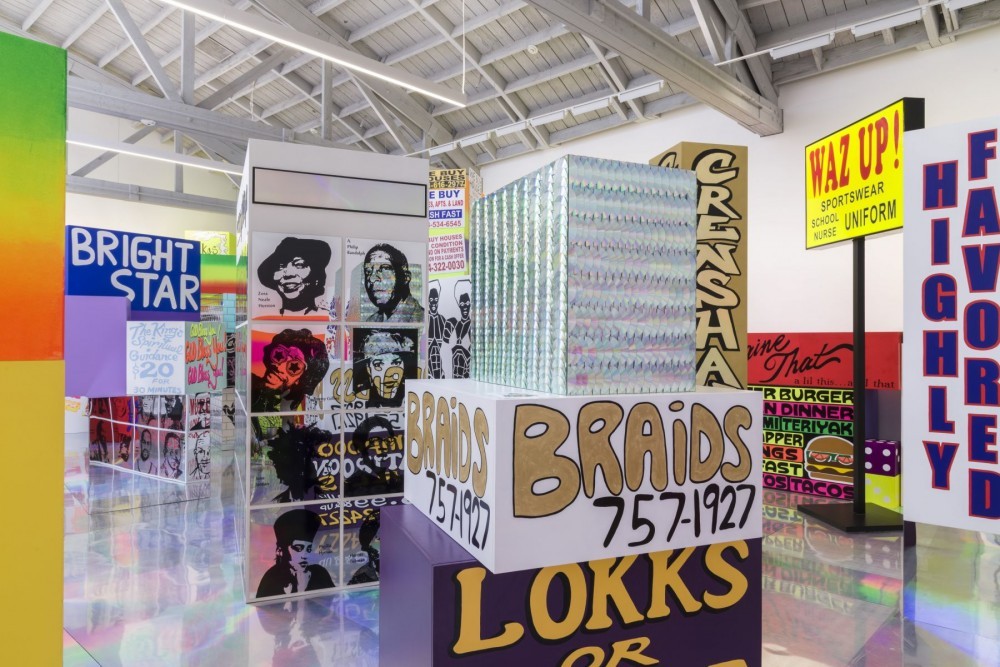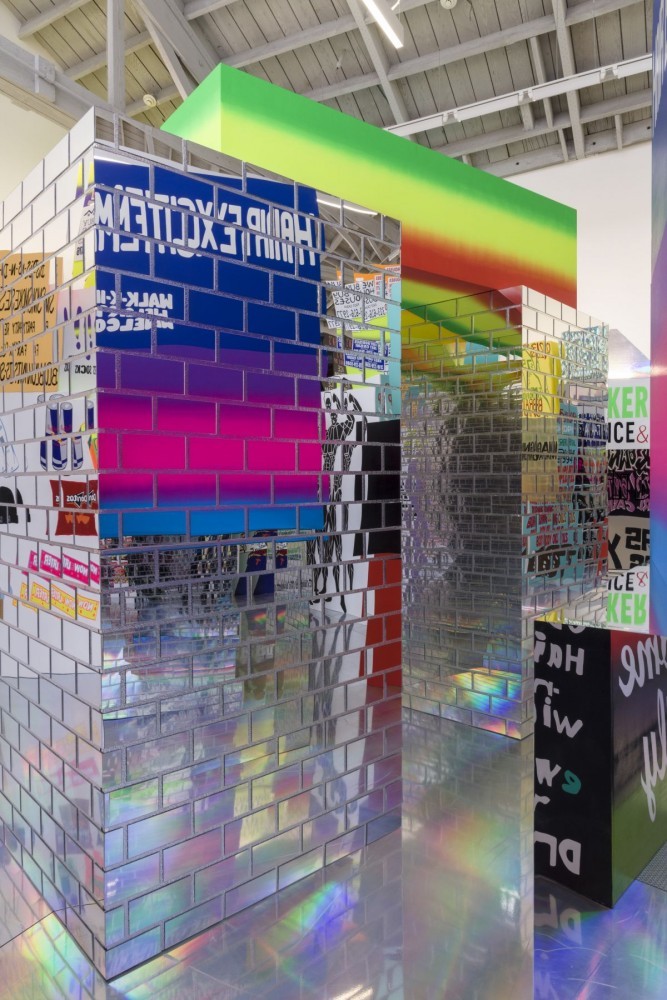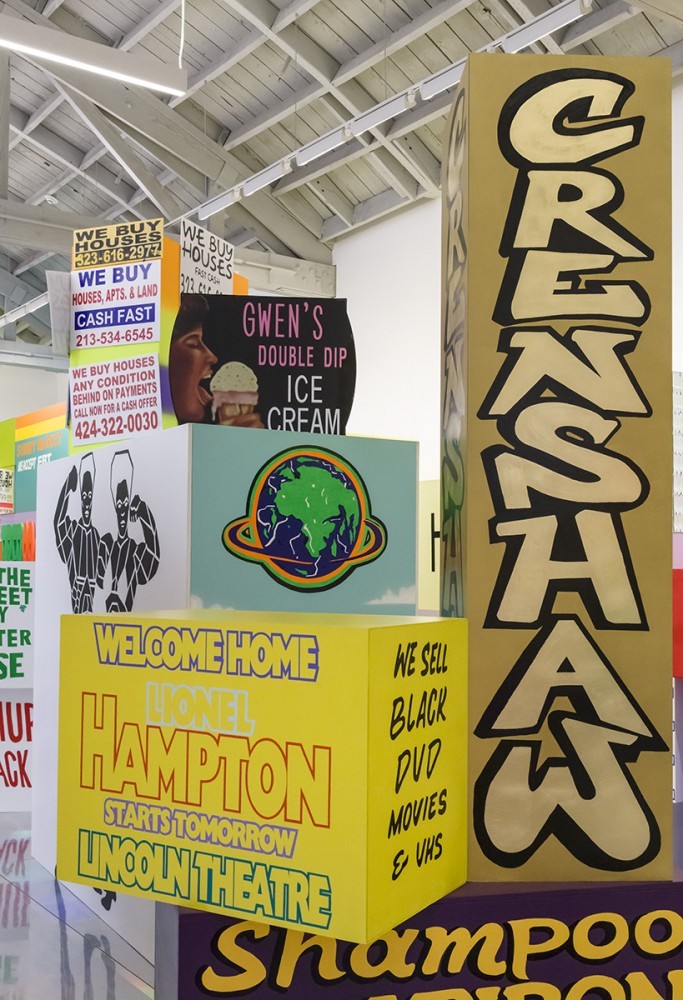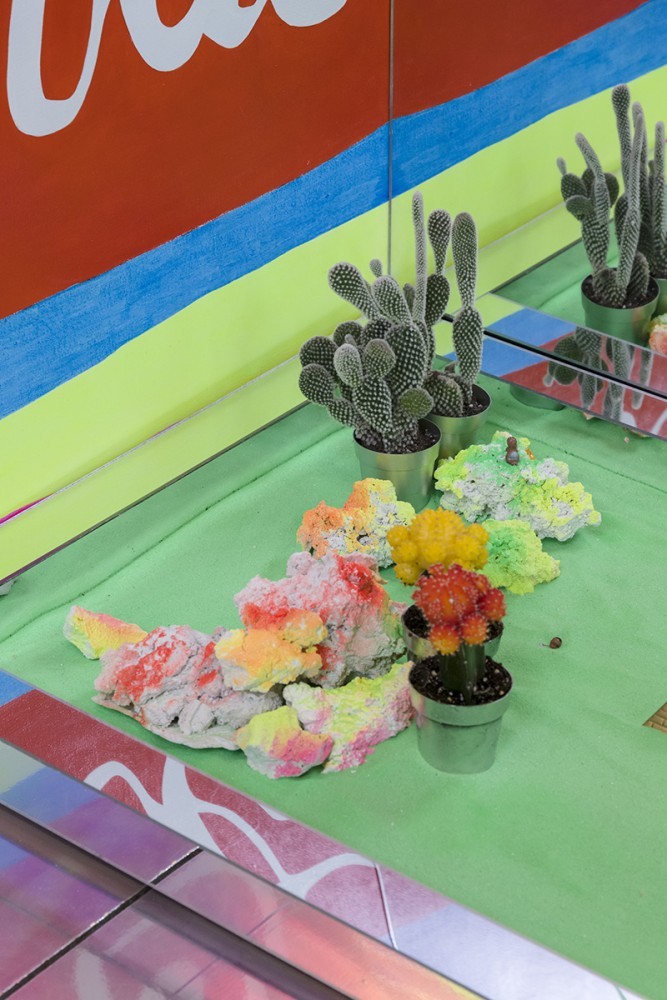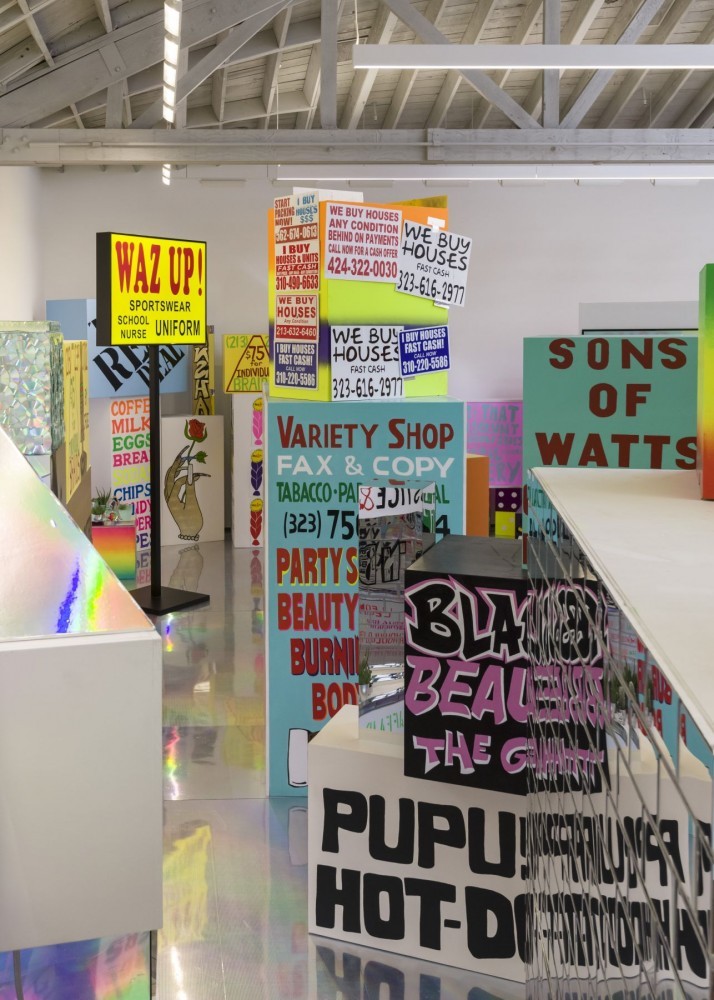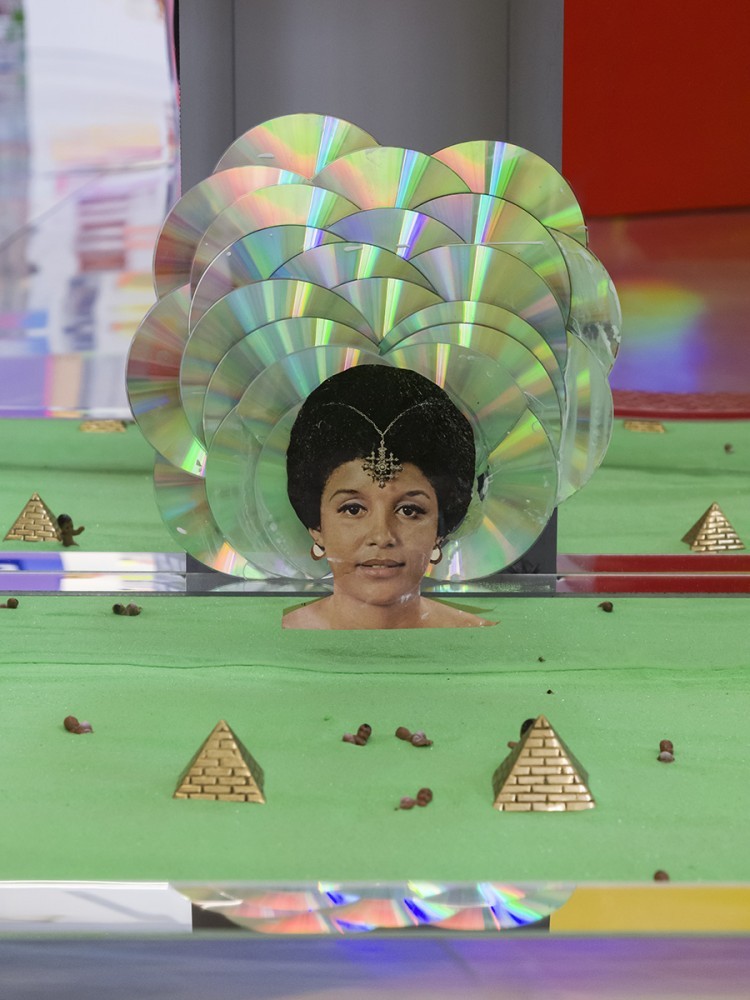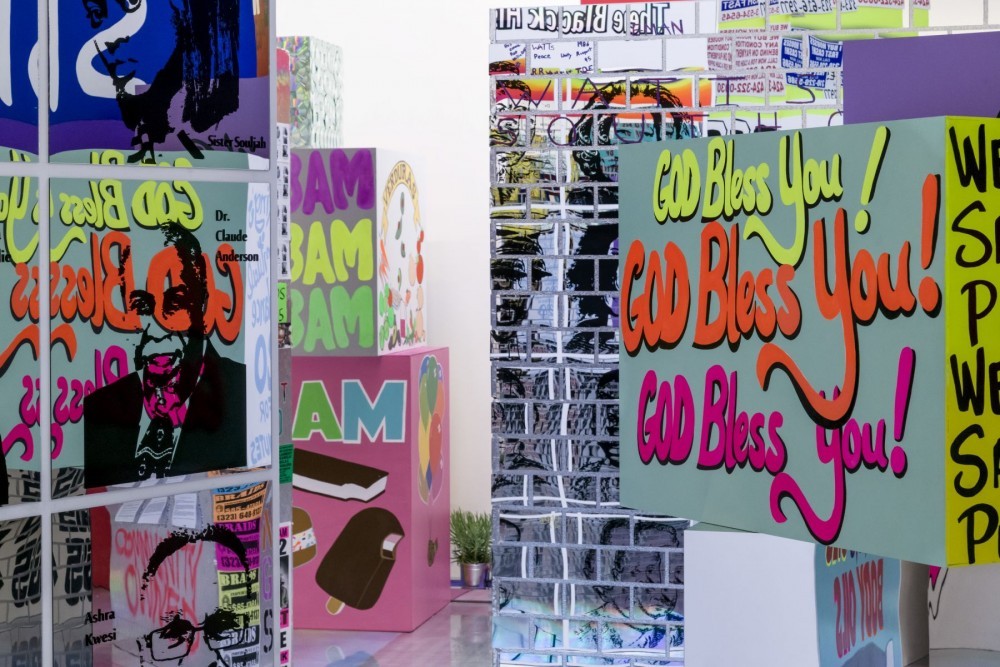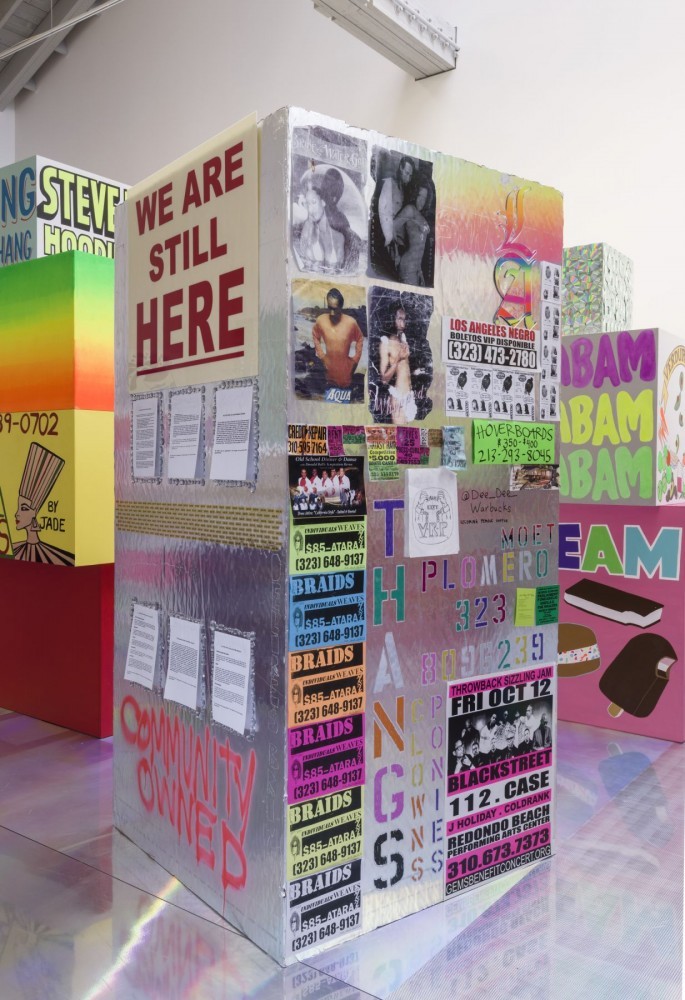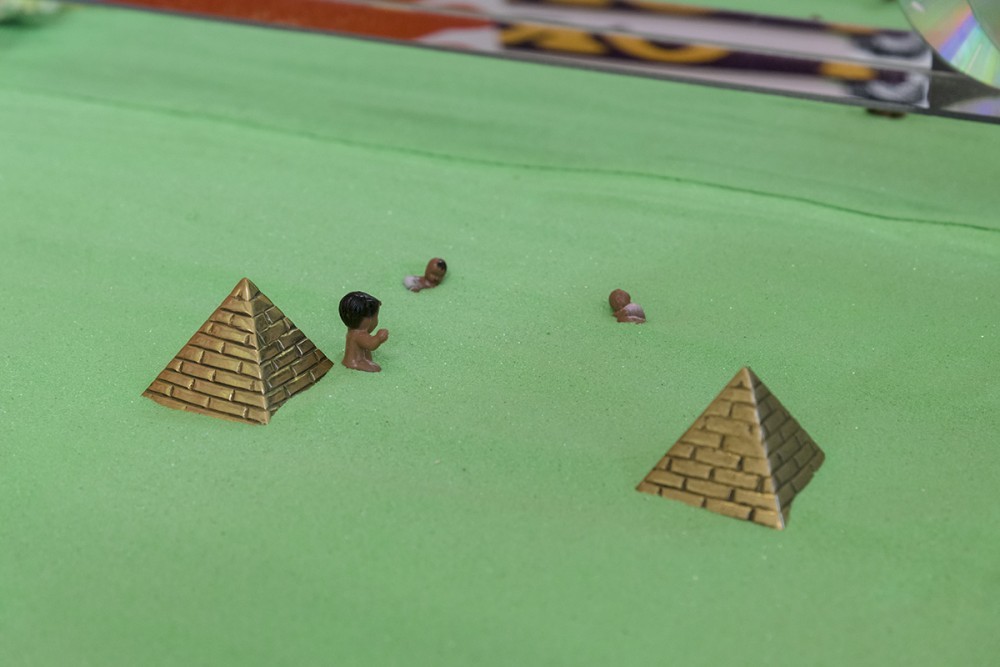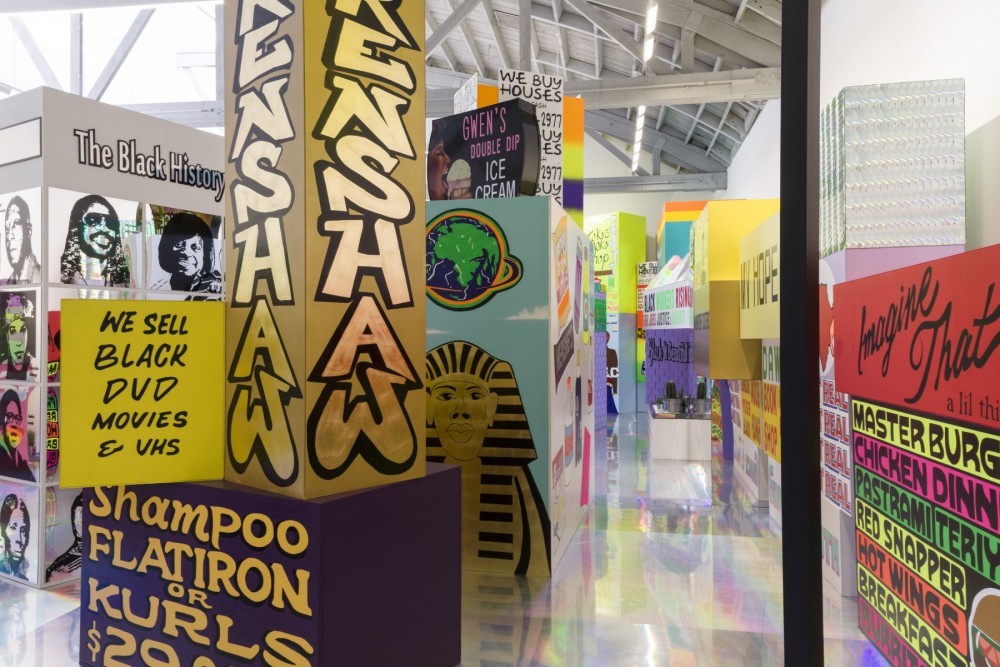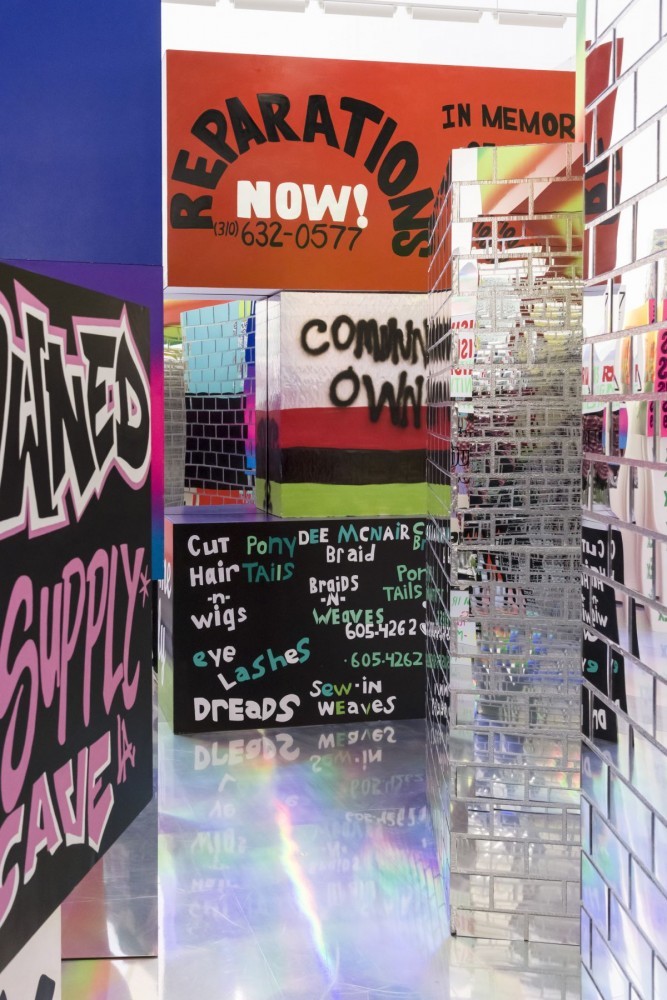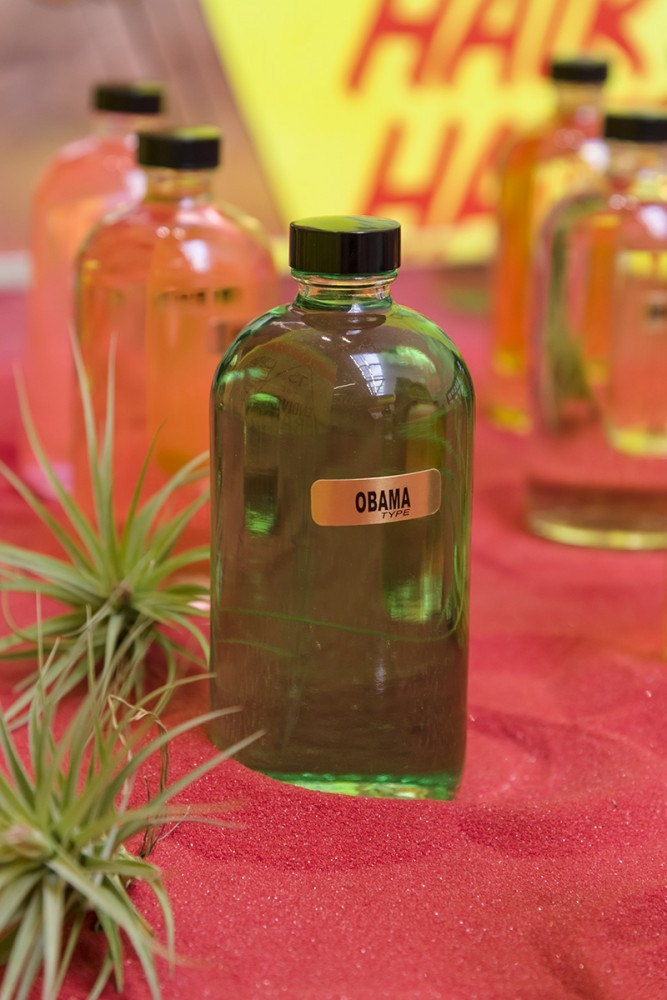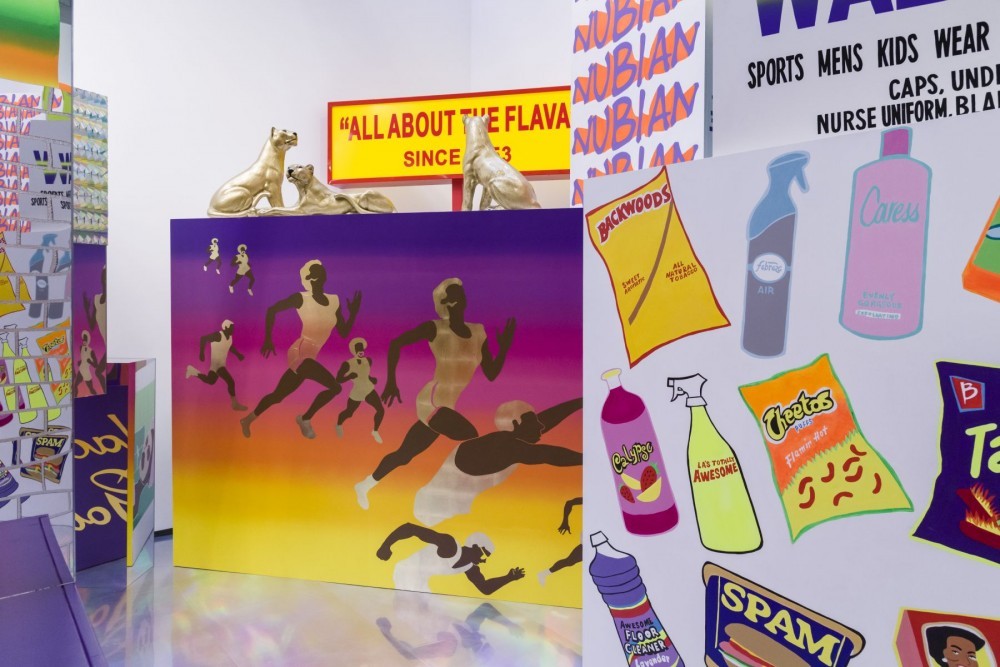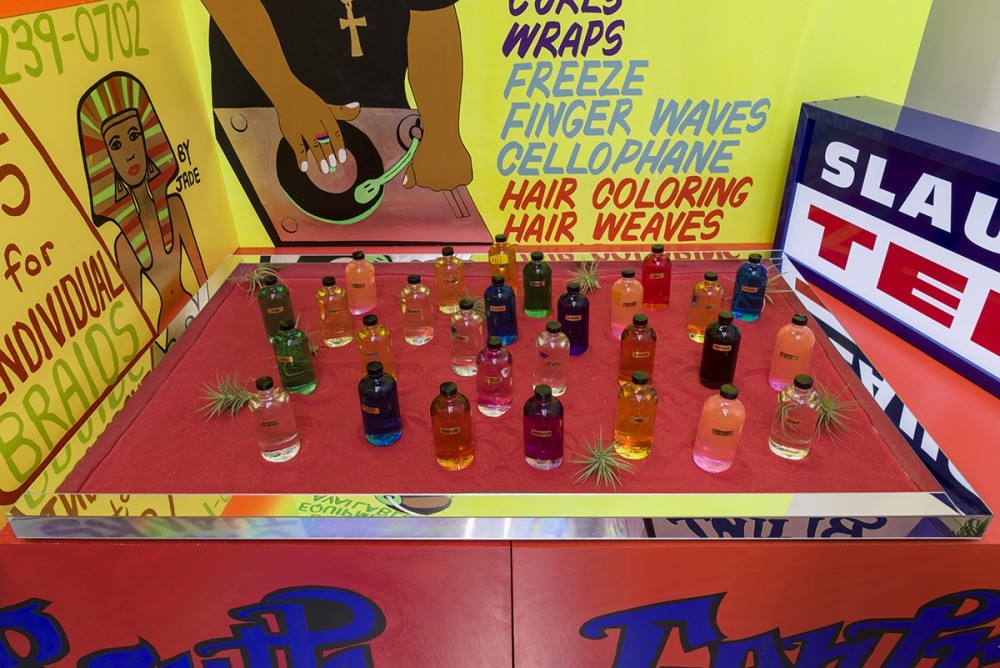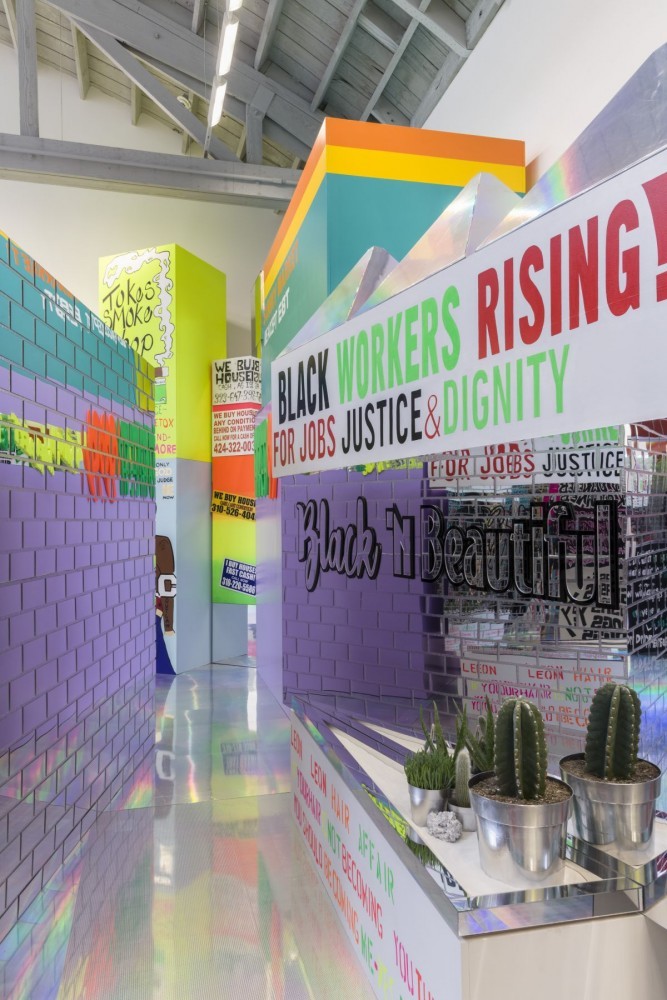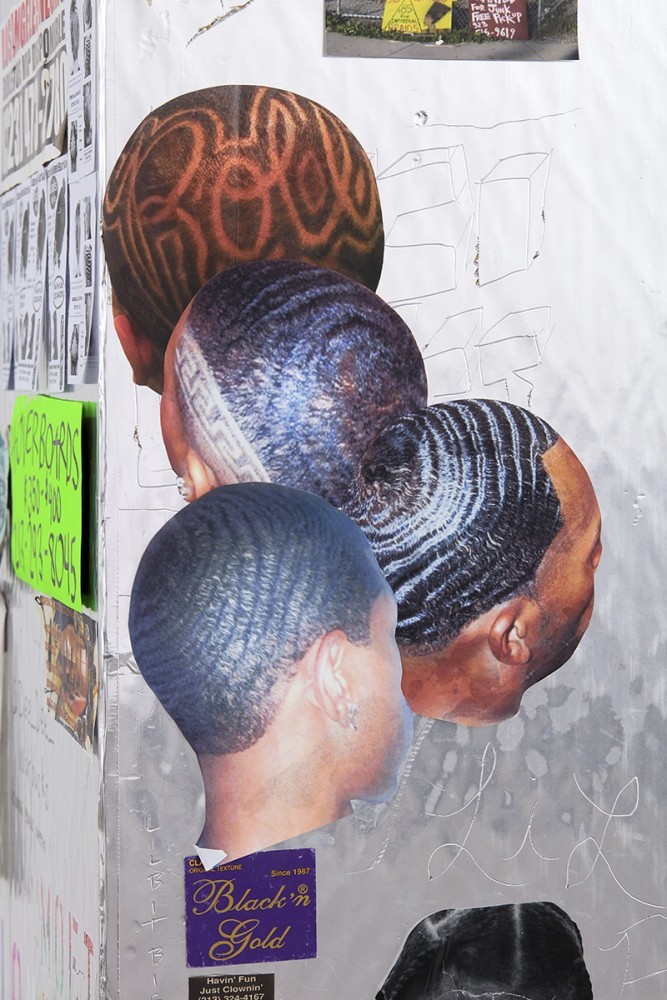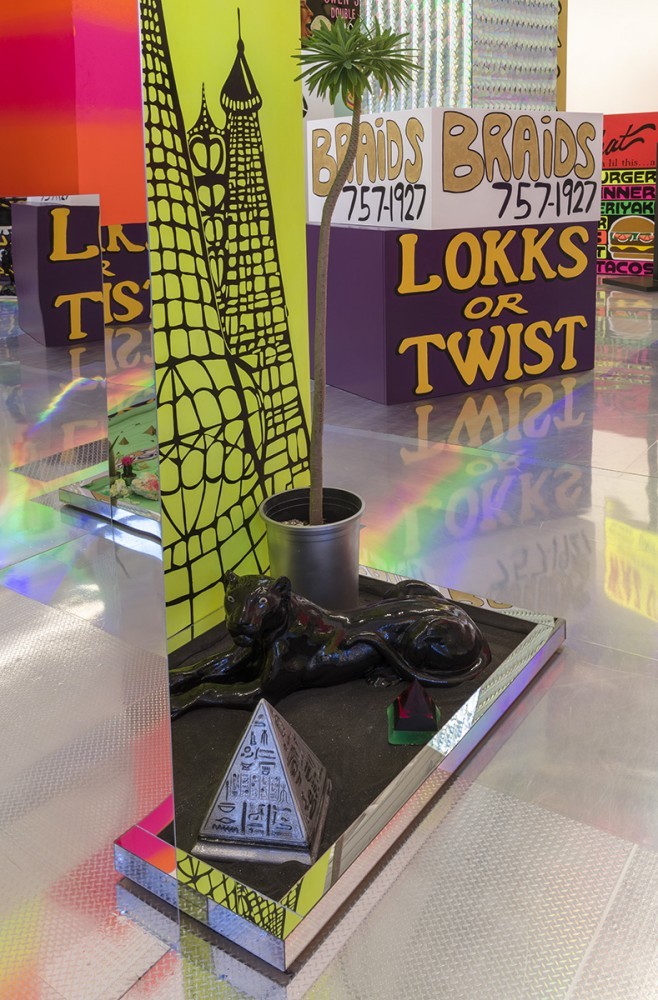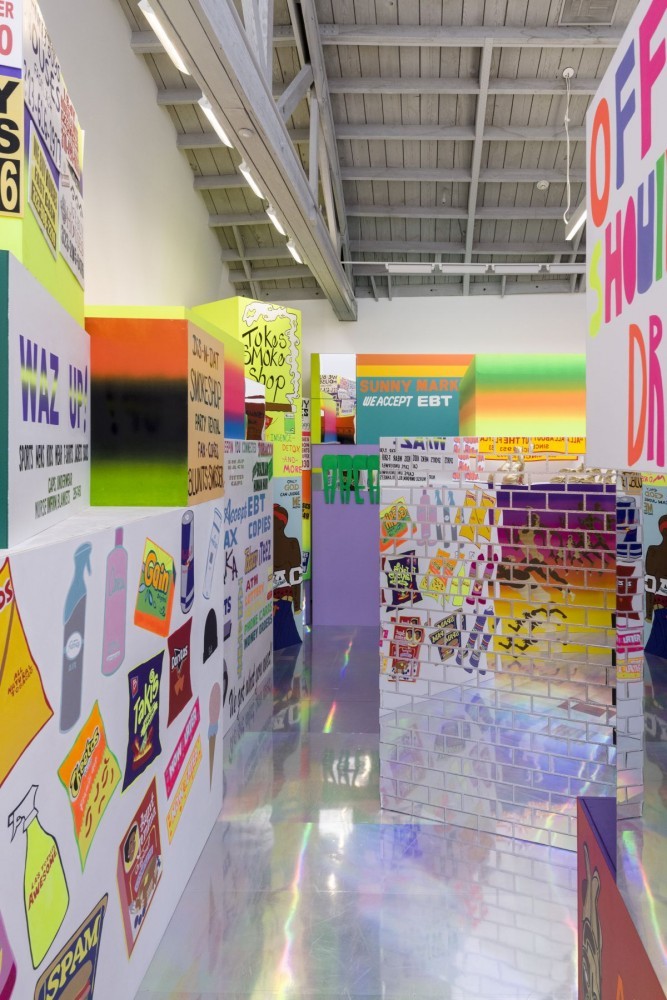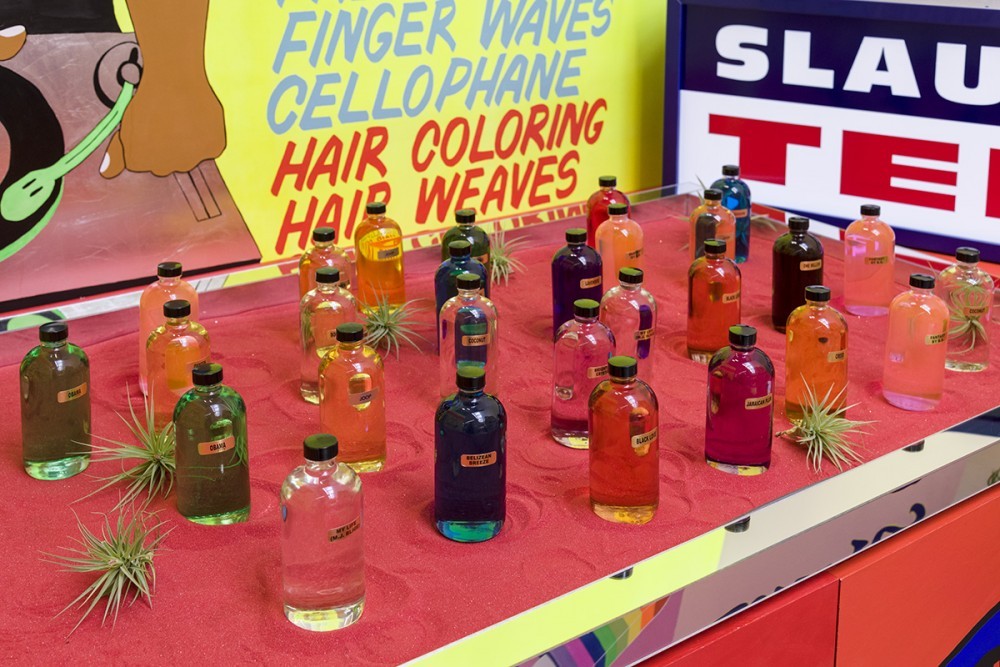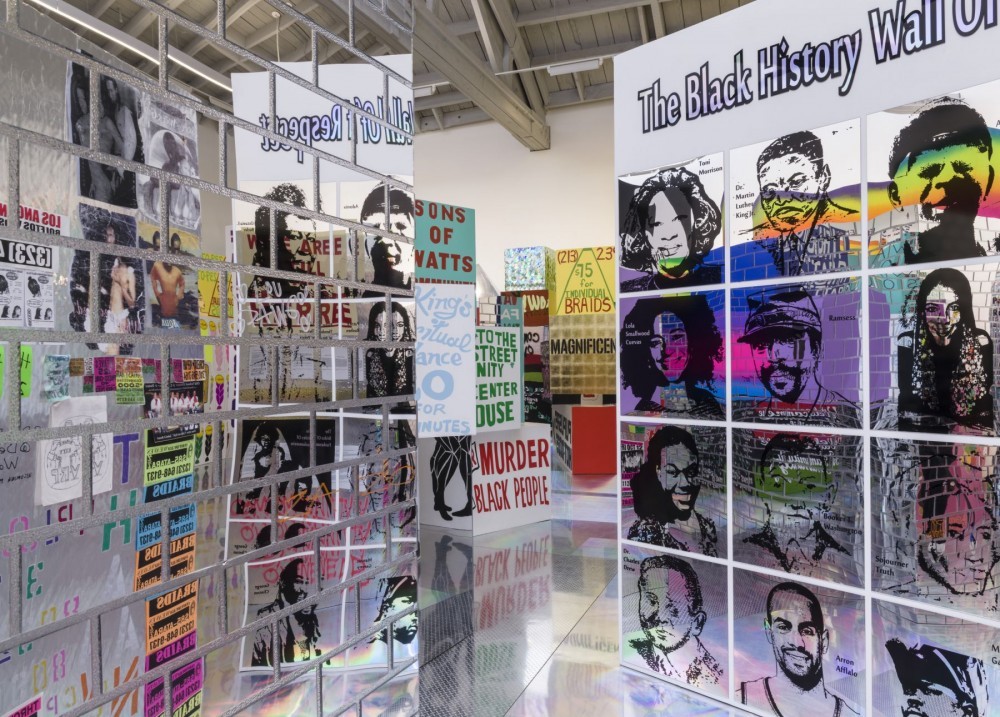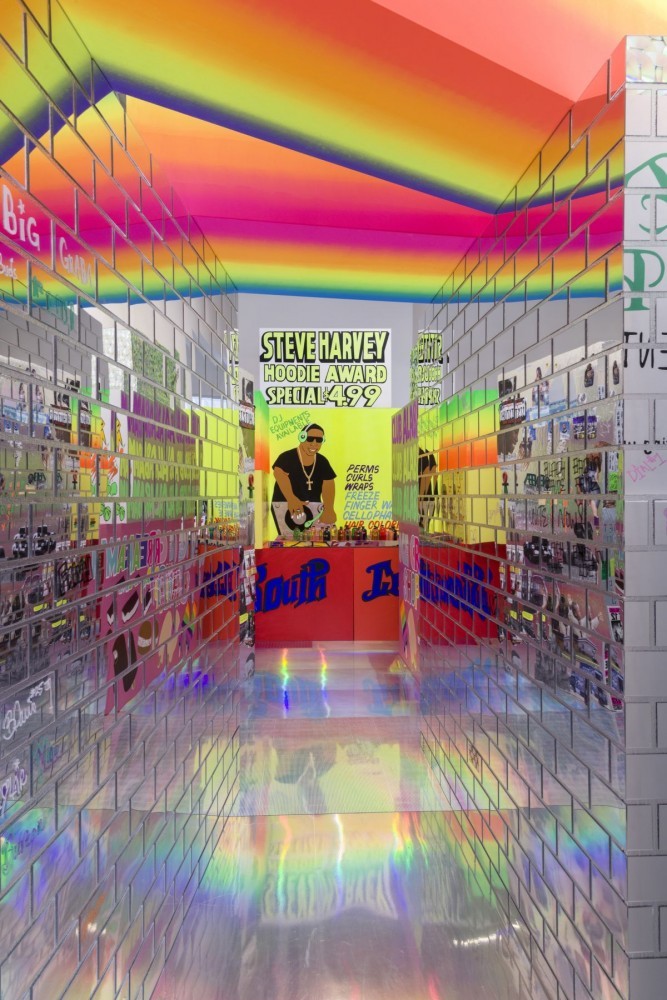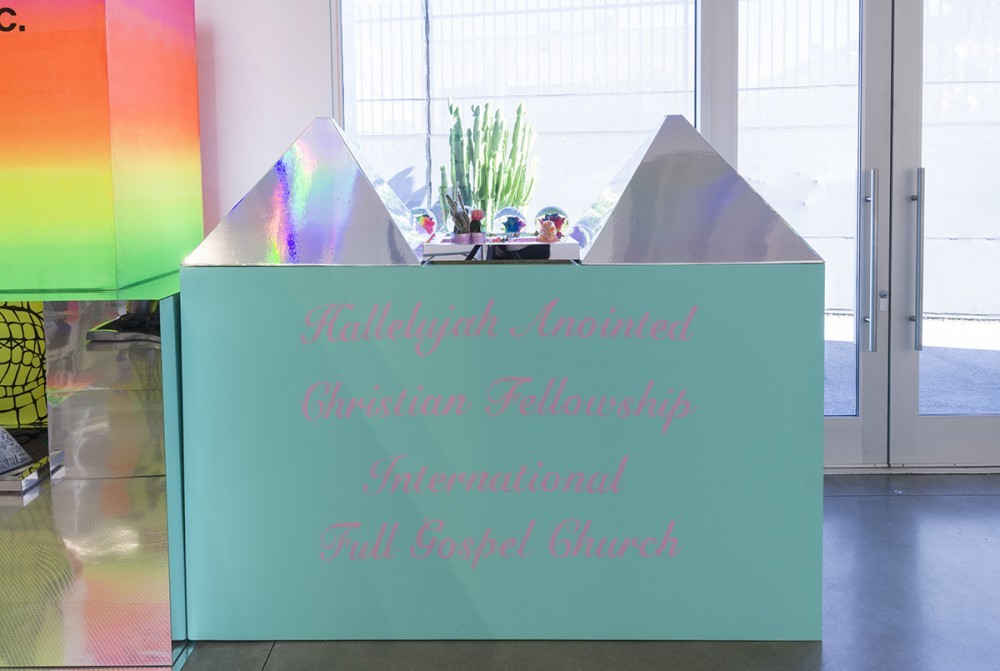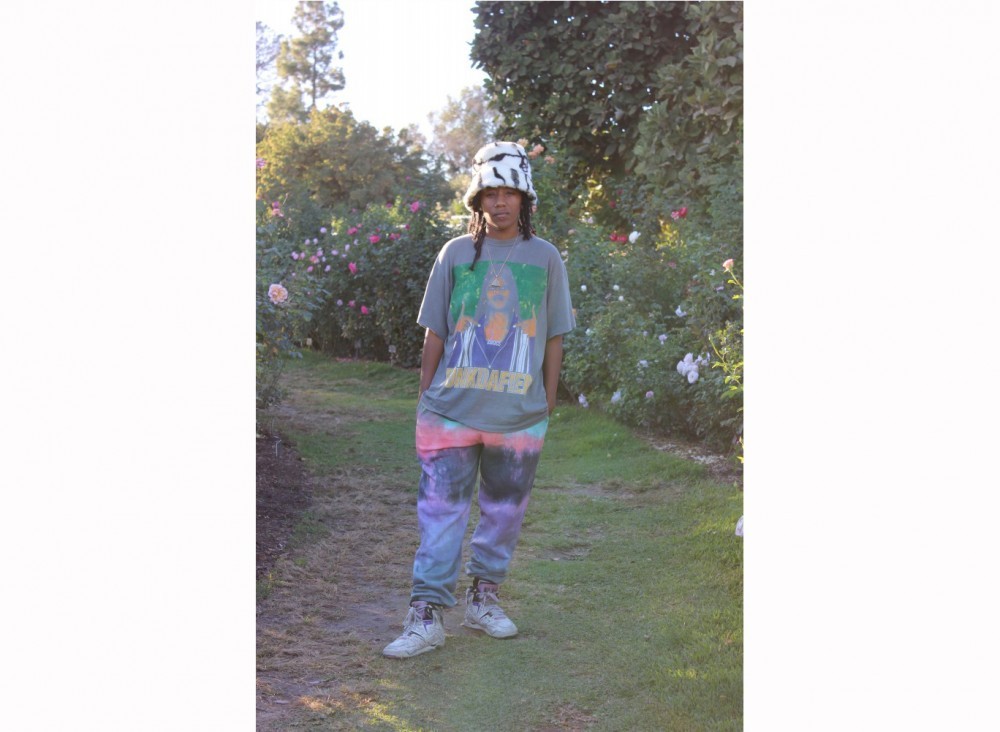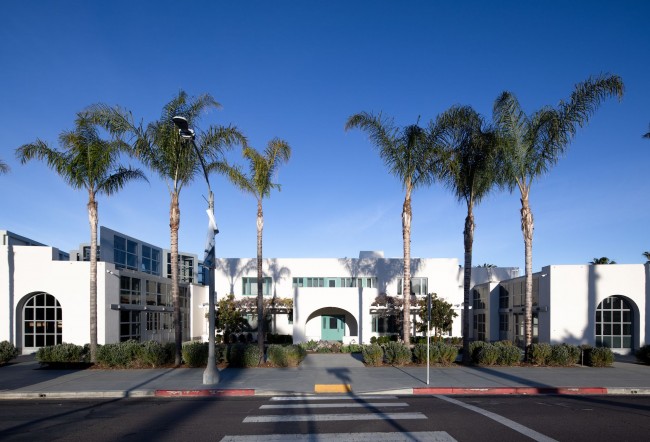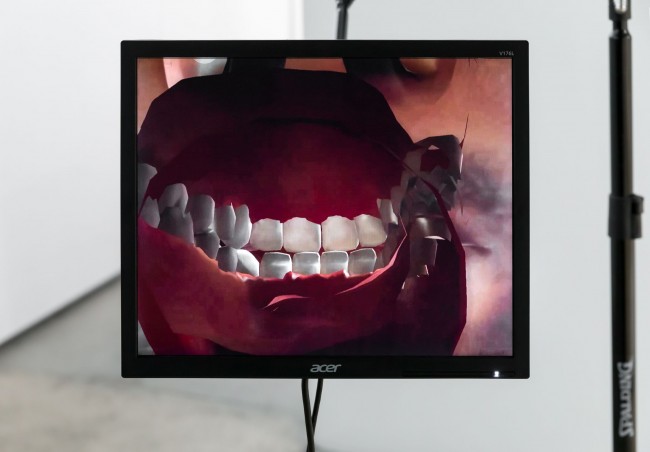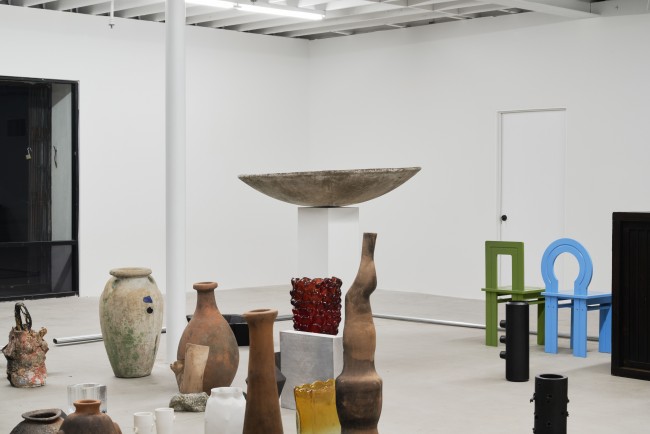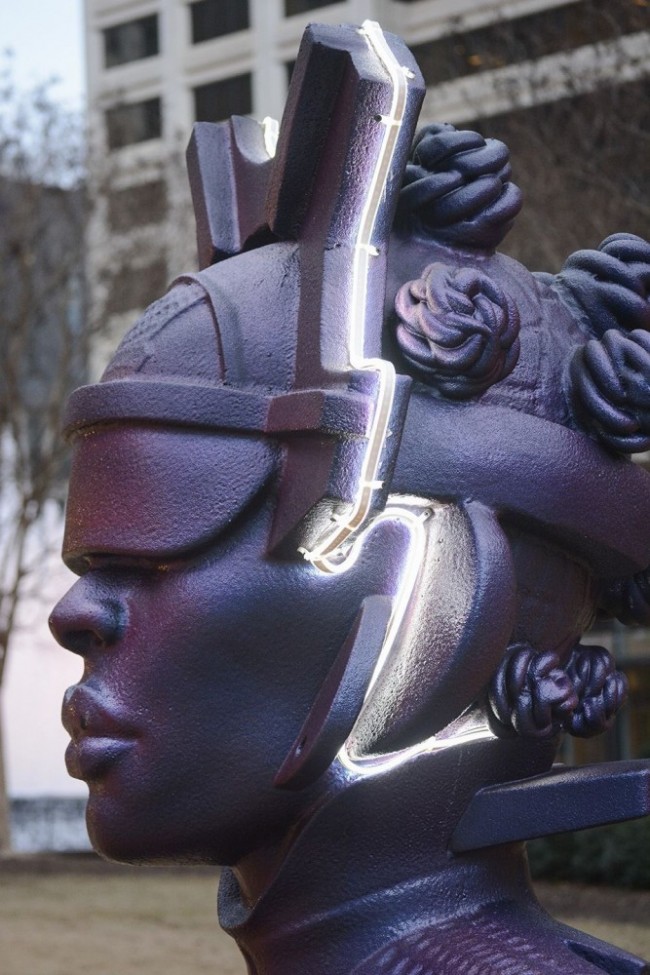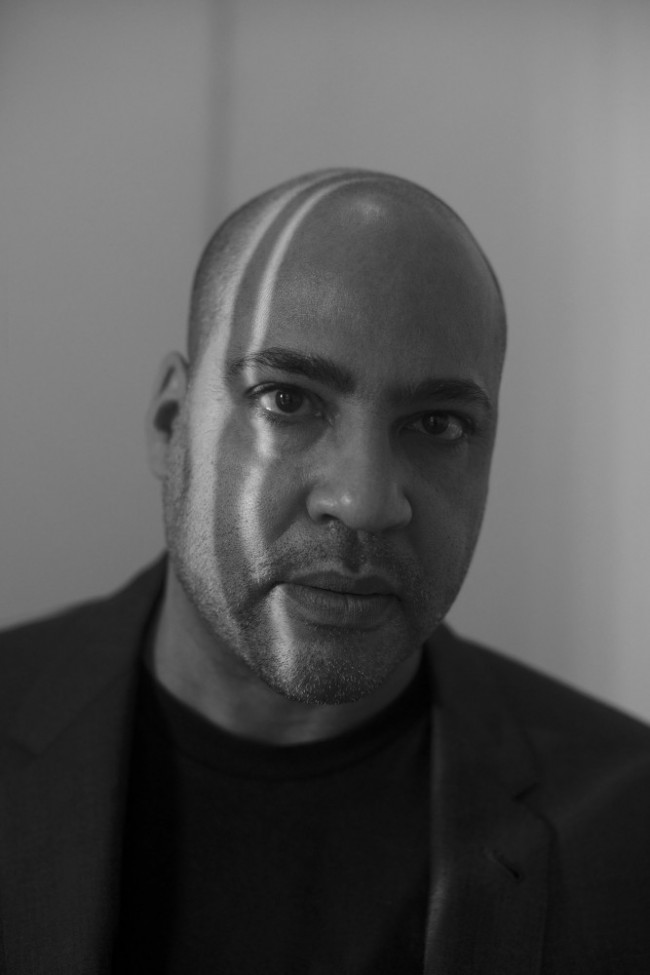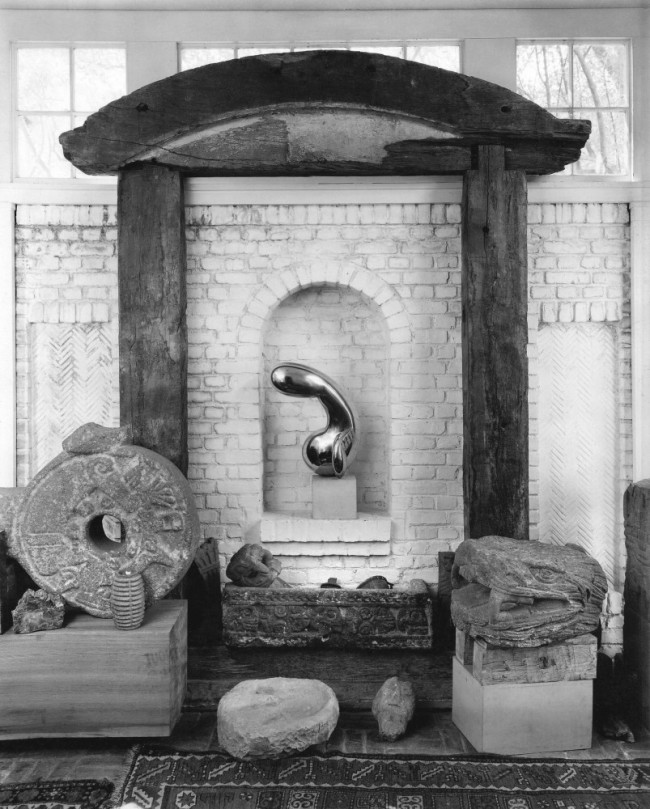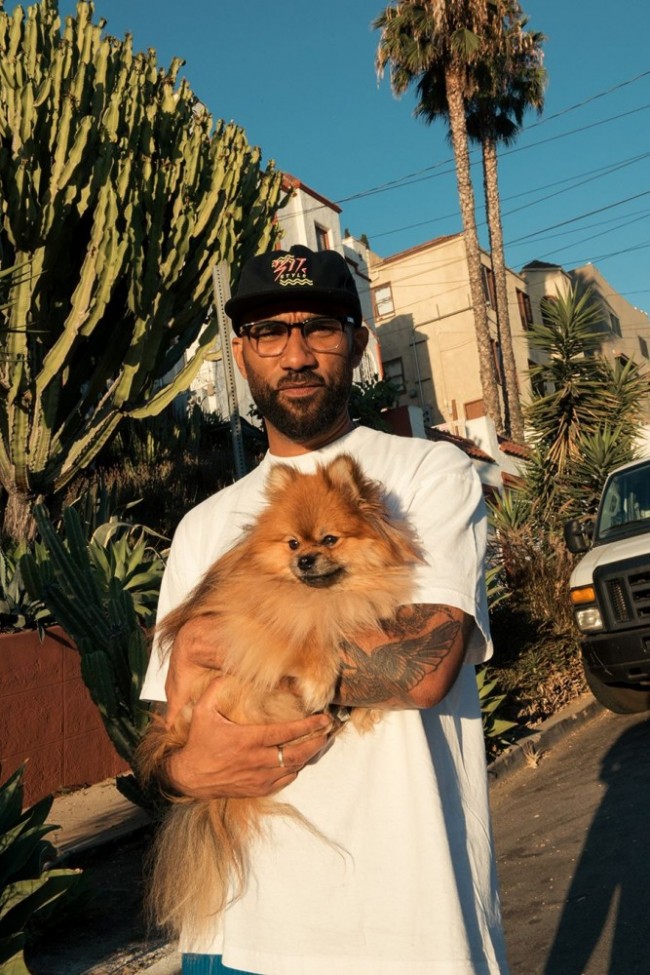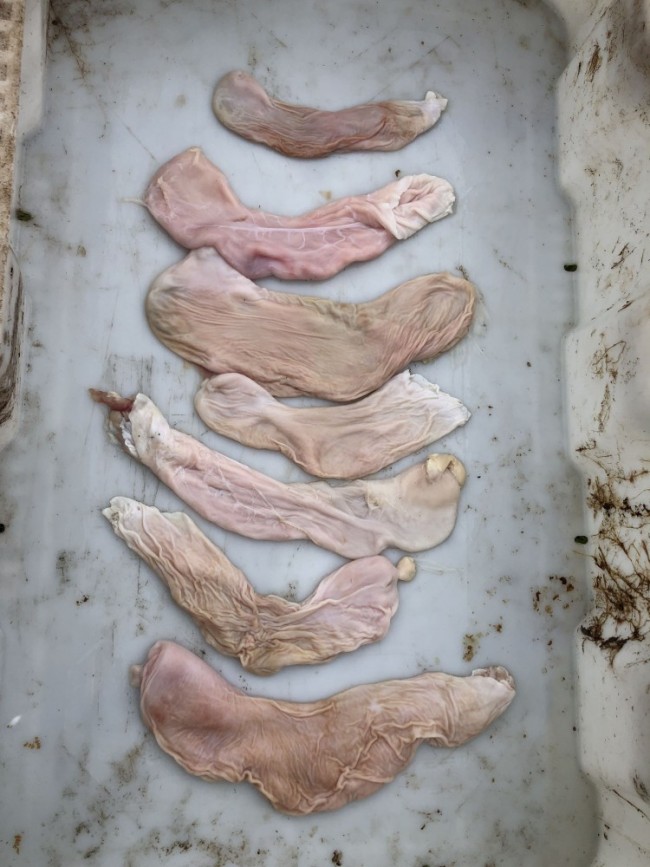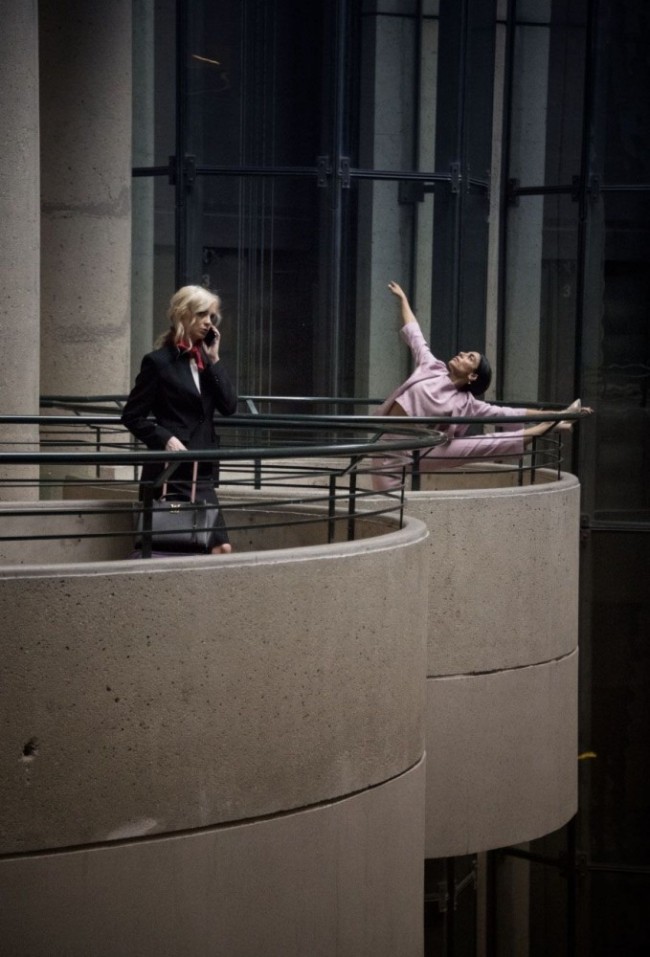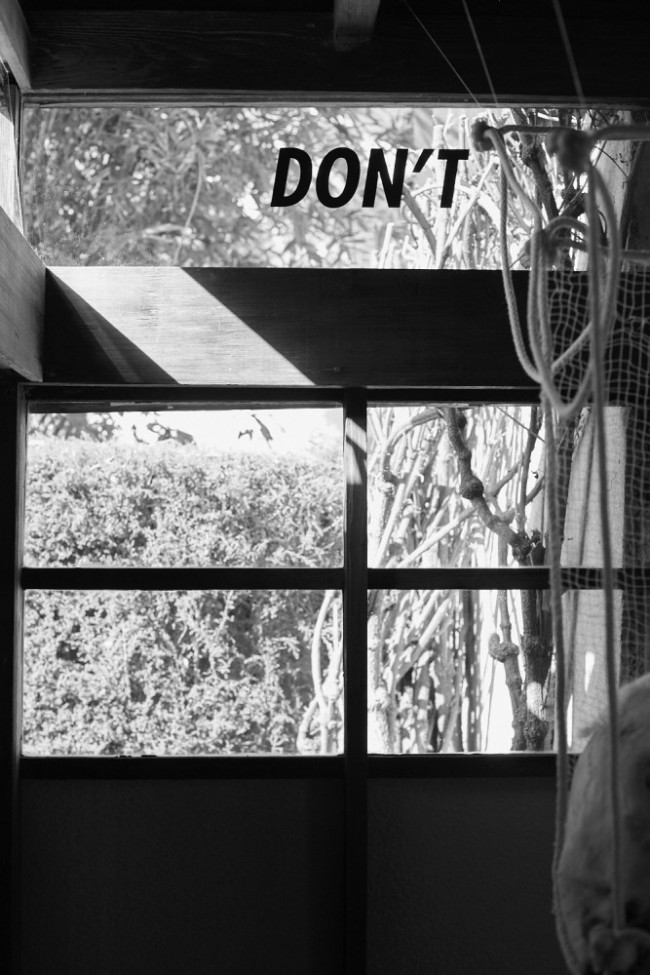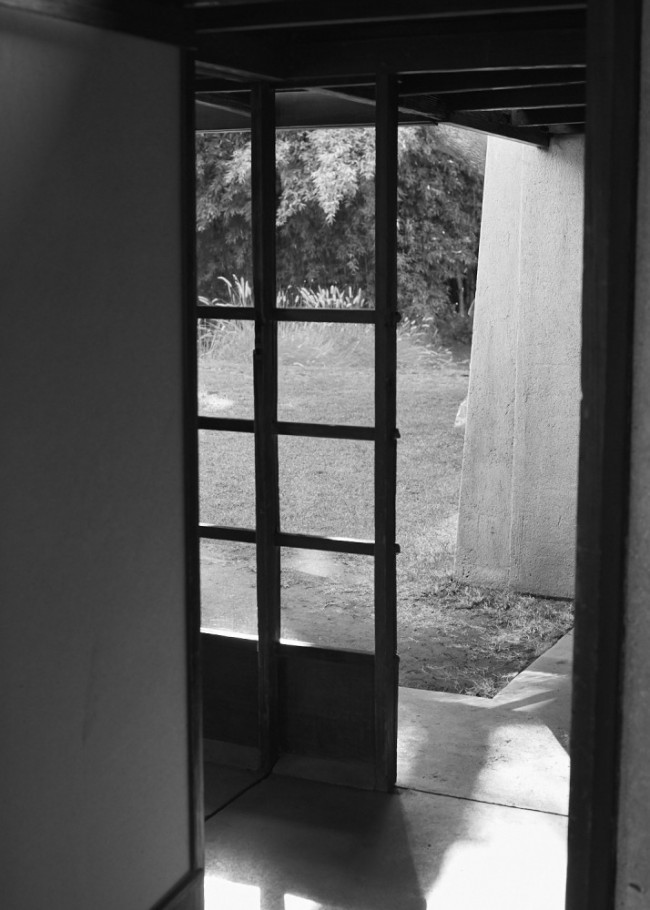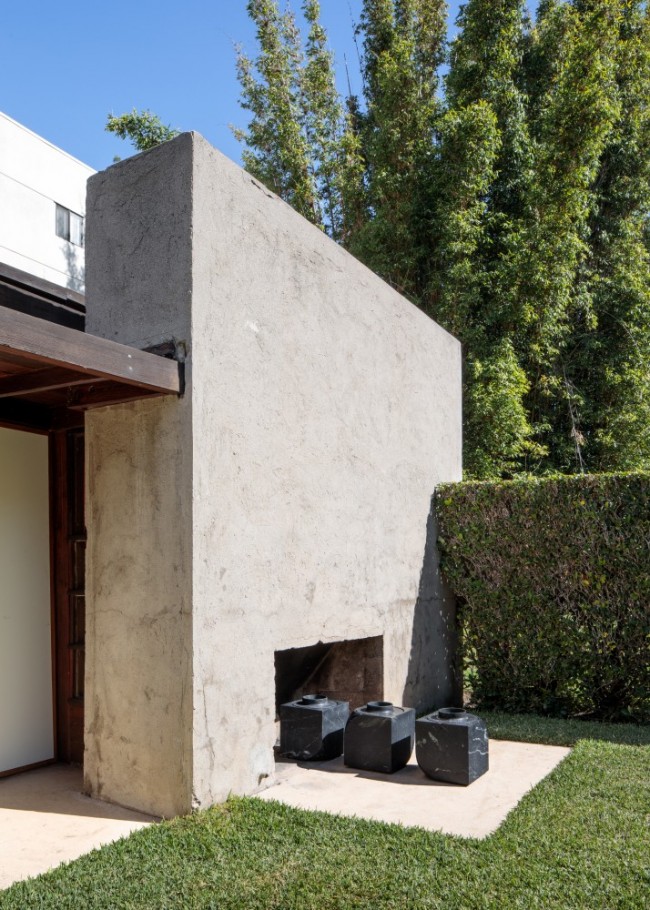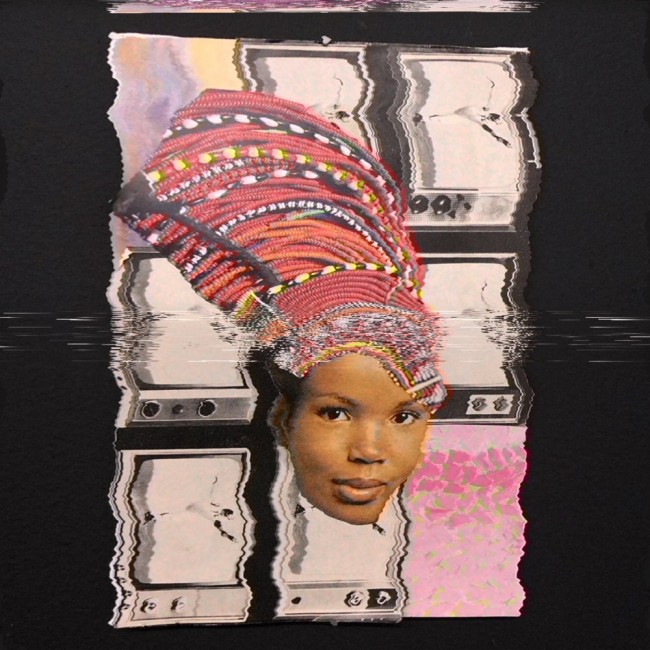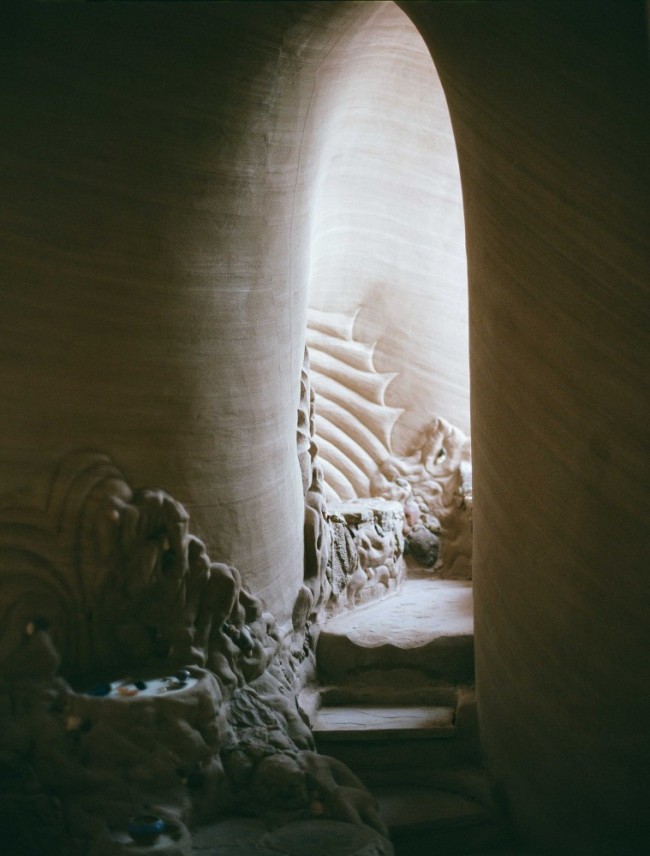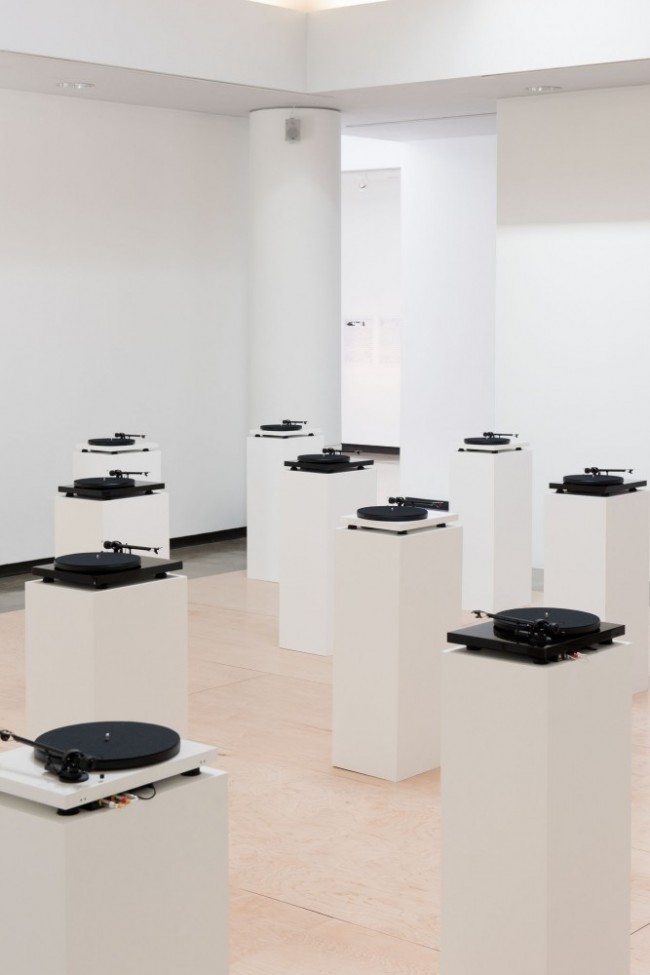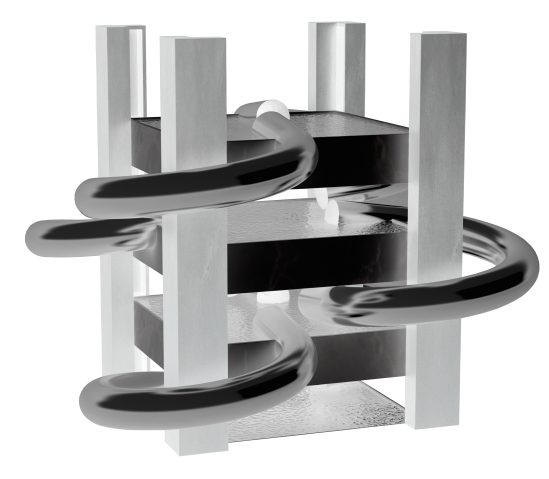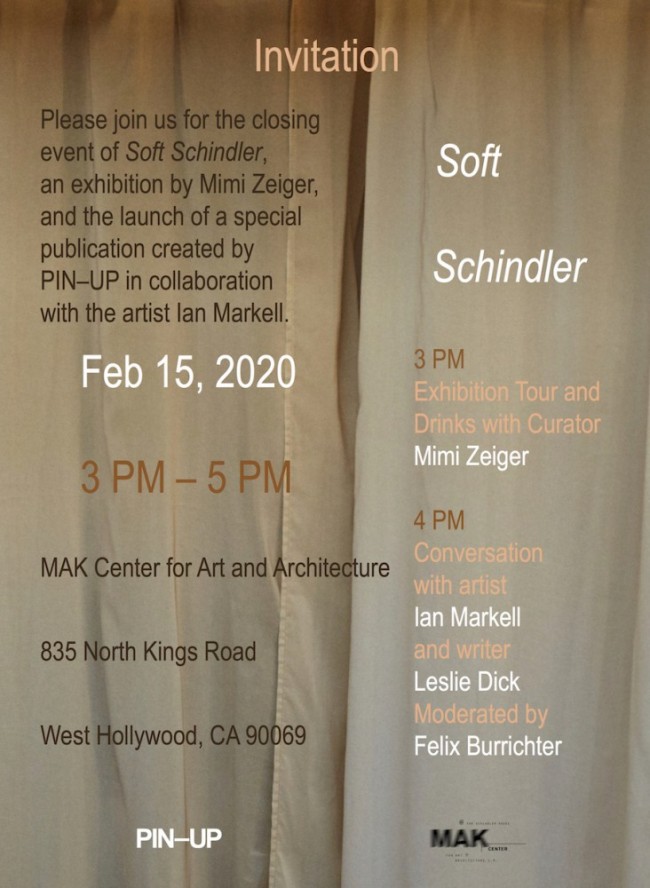INTERVIEW: Artist Lauren Halsey On Her South Central-Inspired Afrofuturism
Artist Lauren Halsey was born in Los Angeles, and her life and work are intertwined with the city — beauty shops in Watts, neon Colby posters, and the cheesy grin of Cheetos’s Chester Cheetah. Her recent solo exhibition at David Kordansky gallery was both a personal and urban archive. She filled the white-walled space to the roof beams with an installation that alternates between documenting brightly painted signs and black- and Latino-owned businesses in South Central, gone or facing demise due to gentrification, and modeling a speculative, Afrofuturist urbanism full of prismatic light. Halsey’s art world profile has steadily grown over the past few years, with awards and solo shows at Fondation Louis Vuitton in Paris and the Museum of Contemporary Art in Los Angeles. Young, queer, and black, she’s committed to making work that reflects and empowers not just her individual identity, but also her neighborhood, her community, and her friends, with whom she frequently collaborates. PIN–UP met Halsey before the closing of her installation to discuss, among other things, her plans to open a community center and dreams of becoming an architect.
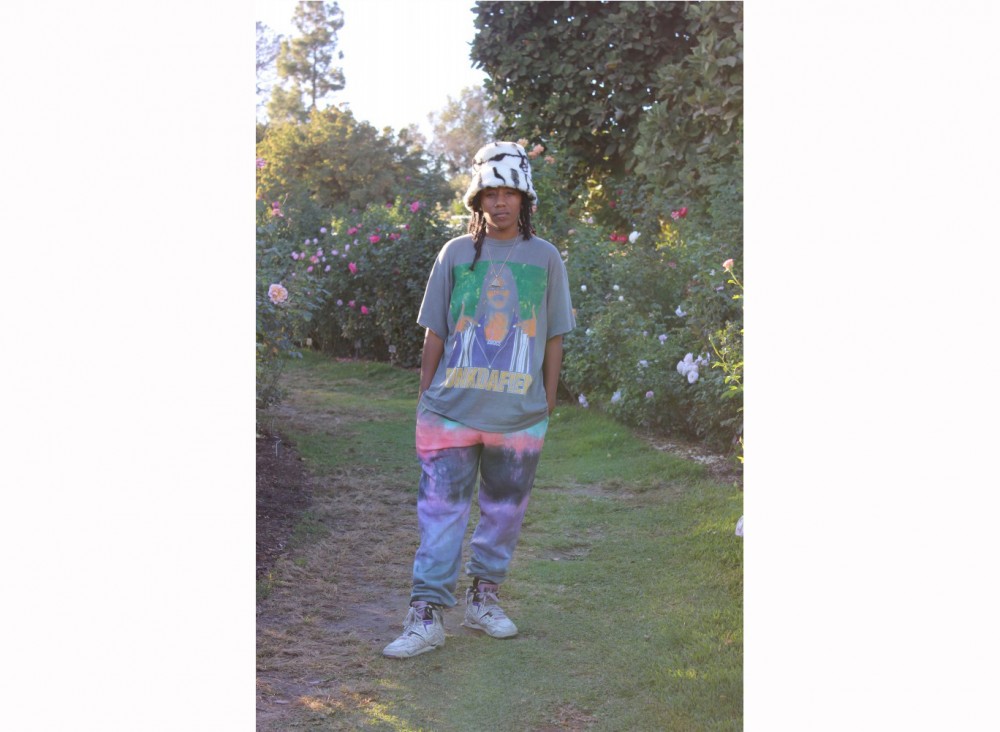
Lauren Halsey photographed by Czariah Smith.
Mimi Zeiger: There’s so much joy in your show at David Kordansky gallery — the colors, the reflections — but there’s also a sense of loss. What kind of tone were you hoping to evoke?
Lauren Halsey: A record of my neighborhood, South Central, through my dreaming of it and funkifying it through my own mythos and palette. For me it was about layering deep chronologies in moments, time, beauty, tragedy, and loss. What makes a neighborhood a neighborhood? People. And people come to be through the aesthetic experience of these places.
I was interested in proposing a space that is my version of a fantastical architecture about stacking, layering, remixing, and sampling all sorts of archives. Archives specific to South Central. But South Central isn’t just one thing. There are sections of South Central, like the section that my family has been in since 1927. My father would call it downtown South Central as opposed to USC South Central.
I spent lot of time in South Central libraries, just going through everything from community leaders and heroes, to very ephemeral but powerful grassroots organizations that came out of a moment. What people were reading? What people were proposing? The exterior façades of neighborhoods, I’m lifting that too.
For example, I was looking at a picture of my grandmother in front of her church and noticed signage for a business in the back. That is a portal in time. I start in 1927 and go to now. Interestingly enough, since the show opened, five of these businesses represented don’t exist anymore. I painted my favorite paintings that I knew would disappear, or will disappear, for whatever reason, gentrification. I wanted to freeze those moments.
As far as the stacking and the box shape of the installation, I was thinking of ways to strip down a building. An architecture absent of all the cladding, absent of any materiality, absent of windows, bars, whatever, will literally just be about the aesthetic experience of a structure and the hand.
So, in some cases, these pieces are actual buildings that you are lifting from the neighborhood?
They all are. None of this is made up or imaginary.
-

Lauren Halsey, The Black History Wall Of Respect, 2020: vinyl, acrylic, and mirror on wood.
-
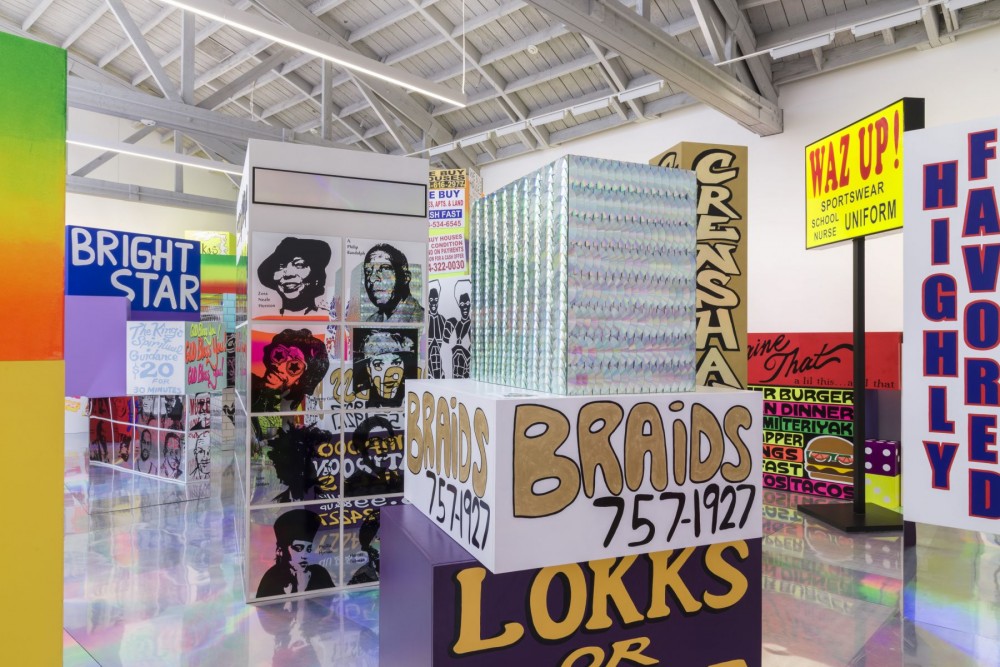
Installation view including The Black History Wall Of Respect, Black Diamonds, and WAZ UP!, all 2020.
-
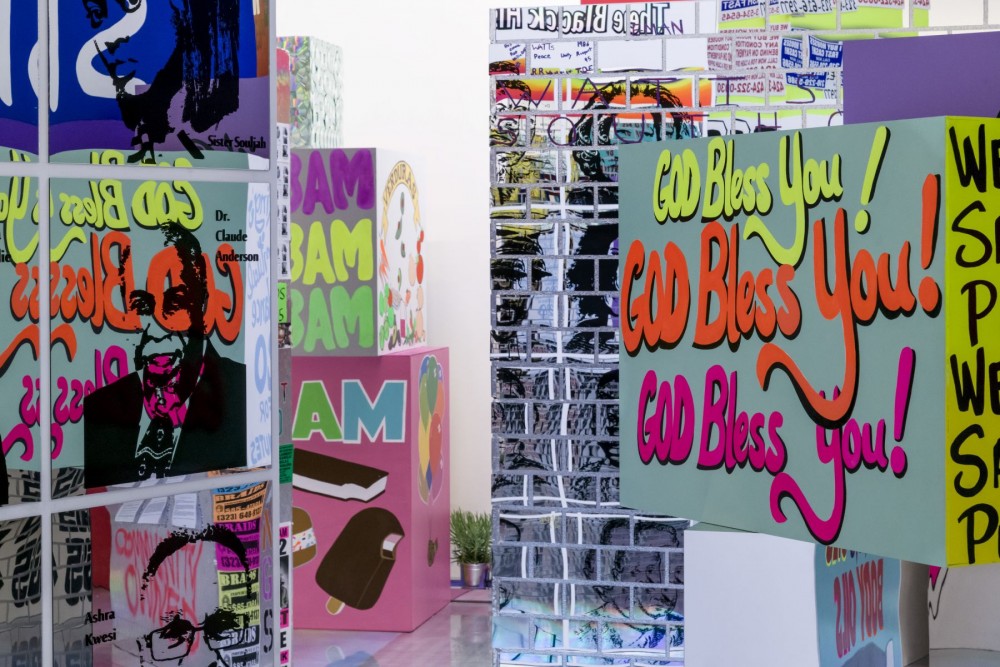
Installation view of Lauren Halsey’s self-titled exhibition at David Kordansky Gallery, Los Angeles, January 25 to March 14, 2020.
It’s a personal and urban history. You cannot disentangle the two from each other.
Absolutely. Of course, it’s myth as well. I reimagine what my grandmother and her siblings were doing in their leisure time. What they were doing to empower themselves, businesses, and other black people, especially on Central Avenue during the Jazz Age, like in the ’30s and ’40s. And reimagining my mother and father and their leisure, their politics. And then bringing in mine.
You’ve brought up the idea of leisure a couple of times. When we think about neighborhoods, we usually think work or civic space, but we don’t necessarily think about leisure. What does leisure mean for you?
Moments of pause, moments to be playful, moments to curate and think about style, moments to hold space, like Crenshaw Sundays, Sunday Funday. Now the police have ruined it. It doesn’t happen anymore. But for the majority of my life, every Sunday on Crenshaw it was just this exodus of low riders and gorgeous cars, and they would bounce and hop. So that is like a moment of leisure.
And beauty, right?
Yeah, absolutely. Like the colors in the show, some of them are true, of course, but I was also thinking about abstract bands of colors that I’ve seen in the city as a palette that’s definitely ours, which I’m obsessed with and think is pretty.
My whole life is inspired by Colby posters. Colby poster traveled everywhere: all over of South Central, all over L.A. They told you that the Delfonics are playing, or where to get your hair done. So, Colby posters are part of my palette. My grandmother took me to visit the print shop right before they closed in 2012. I made a series of signs about business ownership and redistributing and pooling resources as a community, and genocide, and blah, blah, blah, blah.
And also, I was thinking of striped walls of colors that I had seen, or a striped car, just gorgeous colors that I’ve seen. But what’s wild about this palette is that it’s on bodies too. What I love so much about L.A. is that you can be on a bus or in a car, and you pass by a business that’s brightly painted, and then a woman with weave with all of those same colors passes by. The sunlight, the senses, and, you know, the abstraction of these bands of colors on buildings, on bodies, on cars — that’s what I was trying to summon.
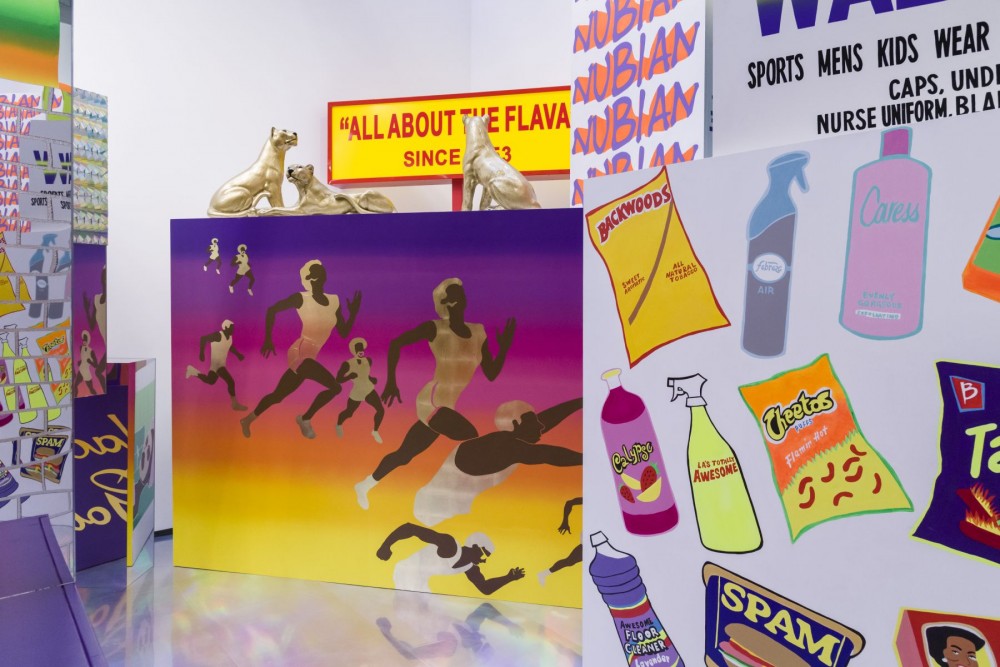
Installation view of Lauren Halsey, including ALL ABOUT THE FLAVA, Nubian, and Main Discount, all 2020.
It’s there. I’m totally in love with the iridescent floor and the mirror reflections that are kind of hallucinatory.
I wanted to expand and stretch the room, but I also wanted to create these infinite lines of vision. And I wanted to chop and screw or pixelate and isolate moments of text and color. And, most importantly, I wanted people — black people — to be able to see themselves. I was thinking of a prism environment where no matter who you are, you are washed in glow.
There’s tremendous complexity to the arrangement in the gallery. You fill up the whole space. How did you plan out where everything was going to be?
For about five years I’ve been making these maximized Afrofuturist paradises: exercises in how to think about maximalism but keep it tight. How to think about density but keep it loose. As far as the organization and the spatial logic in the gallery, I got a space across the street from my studio that was available, luckily. The timing was perfect. I was able to arrange the clusters and the totems minus the mirror. Within the gallery, the composition and organization of the clusters was a visceral-emotional-body thing. I set it up with my friends and my girlfriend. I made decisions based on how our gazes would line up, and how they were moving in space.
Much of what you’ve done culminates in this project. Your MOCA show, we still here, there (2018), was an interior. The Crenshaw District Hieroglyph Project (2018–19) at the Hammer is a monument. And then you transformed the David Kordansky gallery into a city. You’ve talked about dreaming of Afrofuturist utopias. Is this an Afrofuturist utopia? Or is this the city we live in now? Where are we in time?
That’s a good question. That’s the cool thing about Afrofuturism and P-Funk, you’re everywhere at once. I’m in 1927 but I’m also in 2020, and also in tomorrow. Even though this project is to scale of architecture, it’s still a model. And I think I just make really big architectural models. My dream project, one of my dream projects, is to figure out a way to own land and actually build up and accumulate some sort of fantastical remix archive of the city without having to take it down because another show is coming. And then program it in a way that people can truly occupy it in the way that I would desire, as opposed to “don’t touch the art.”
You’ve referenced your mythos. I imagine that in drawing blueprints of futures and cities you’re dreaming at an enormous scale.
I’m obviously inspired by neighborhood in South Central and my family and friends, but on a very personal and deep level, I’m inspired by black alternative theological groups that have the same weird, idiosyncratic obsessions that I have around myth making and ancient Egypt. That drives me. That gives me the energy to build the Crenshaw District Hieroglyph Project. And then within the culture of Egypt remixing and all that — beautiful pyramid builders and designers, who also don’t have degrees in architecture, but who were at the time building and proposing actual architectures in which black people can experience themselves differently and not feel weighed down by some of the oppressive forces, or oppressive moments in architecture that one might experience living in a certain type of neighborhood depending on class.
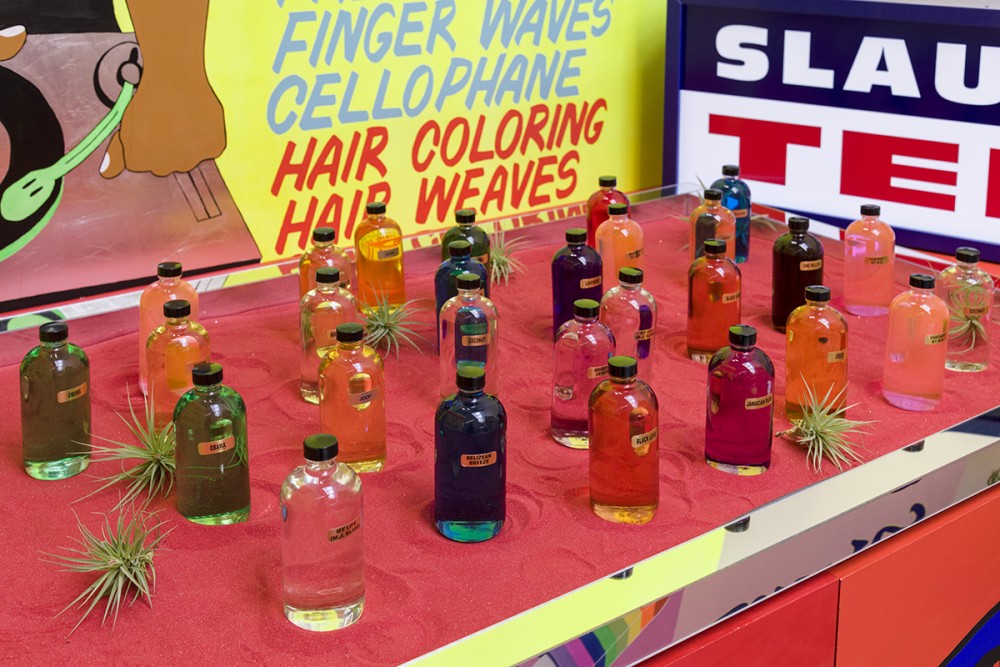
Detail view of Lauren Halsey’s self-titled exhibition at David Kordansky Gallery, Los Angeles, January 25 to March 14, 2020.
As you found yourself in the art world, which so values the individual and the glorification of the individual, is it harder or easier to hold onto your collective ways of working? Are you feeling pressures around that?
No, I don’t even think about stuff like that because the community ethos is the work. I wanted to become an architect. Art was the only way I could get close to that. For reasons that I’ve accepted, I’ll never be able to become an architect.
I think you might be one.
I mean, like math, and other things you have to take — whatever. But there are other things that I want to do as well, like I’m working towards building out my community center. And I’m going to treat it as my first design build project.
A community center? Tell me about it.
I’m opening a community center for children and young adults, aged six to 22, 23. It’s for all my little cousins that helped me with this show, now they have a place to continue to paint. It’s about supporting all sorts of creative intelligence and activity in the neighborhood. Free. And it’ll be everything from how to read, how to write, SAT and ACT prep, and résumé building to gardening, printmaking, sign painting, coding, and meditation. There’s also a plan for a music studio that will offer a residency to a musician for a year.
Where are you in the process?
I have to fix the roof. I want to build these modular units that come apart and break down to accommodate whatever the programming is. So, if the space needs 20 how-to-read cubicles or an open floor for dance, it can accommodate. And then just a gorgeous funk garden in the back.
This all sounds fantastic. And yet we are still weighted down by oppressive architecture. I think immediately about this proposed federal executive order around classical architecture and the disgusting symbolism and structural racism that comes with antebellum architecture.
Yeah. It’s America. No matter where I’ve lived, there’s always a hood, and then there’s aesthetics and cues that let you know that you’ve passed some sort of neighborhood boundary, or architectural boundary, and you’re in a certain class experience. That’s reflected on façades, or that’s reflected on signage — and I don't mean the beautiful stuff, but like “I’m threatened by you” type of things. The "no drug dealing, no drugs, no, no, no" signs, and I’m like dang, I just wanted a Gatorade. The intensity of bulletproof everything. Just all of these material cues; these hard materials and intense and violent. That’s everywhere, no matter where I am. Like in Connecticut when I was at Yale, I’d leave because it was intense, and we'd go to super cool funk parties. Walking through New Haven and realizing, “Oh, I’m in another hood.” It’s the same exact experience, the same exact thing in my gut. I’m hoping to counter that by building paradises where it’s not about that hardness or people projecting their fear materially on buildings and onto me. Just wanting to feel light.

Installation view including The Black History Wall Of Respect, Black Diamonds, and WAZ UP!, all 2020.
This lightness — we are standing next to your huge sculptures, and yet they don’t feel heavy or imposing. They have an uplifting, liberatory feeling to them. Kind of impossibly light, especially with the mirrored pieces.
Yeah, I wanted to butt up against all this stuff and still have fun. I feel like all of these projects have just been sharpening my tools and my material vocabulary to actually take it to the street. I’m just waiting for the opportunity to do that. What it would be like? Would it even matter that I wanted to buy a bag of chips and I have to encounter all this bulletproof whatever? All that’s energy, and it just sucks. All the signs, and then all the pictures of people that have stolen things, and then having to put my money through a little slot. It’s crazy. Would that even matter to me or bother me if I had these moments of funk and love and color? I would probably just be like “that’s on them.”
L.A. is getting built up, infrastructure everywhere. I personally don’t see my neighborhood on the job sites building these condos, or building the train. I want to take it to the next level of representation and actually embodying a FUBU (For Us, By Us) architecture.
Like an empowerment.
Absolutely. I'm thinking about how I can create jobs at the highest level and at the highest rates to build our own architecture, our own monuments? I look forward to working with the L.A. Black Worker Center to employ the neighborhood. They have the carpenters, the contractors, they do masonry. They have everything that I need, and it’s right there. And they’re an institution that’s so important and needs to be sustained. And that takes money. I see it as my own small ethical development project, and hopefully all the developers are inspired. Maybe they won’t be, and it won’t matter. We’re going to do it anyways.
You’ve also branched out into apparel, designing T-shirts for a local print shop and collaborating with Nike. What happens as you start to become a bit of a brand?
It’s all strategically designed to go back to my community, so that’s why I named the Air Force 1 shoes I designed after my community center. It says Summaeverythang on the side of the sneaker, which is the name of the community center. It’s about figuring how to pool Nike’s resources, which are infinite, to empower other organizations, other people, children. It’s always about recycling the dollars back, recycling the opportunities back full force.
To be able to dream aesthetically and urbanistically at scale, which I know you do, and then you find yourself orchestrating these other changes as well, it’s an enormous task.
Ethically, I have to or else I wouldn’t be able to sleep at night. And then what is it all for? Then it would be a spectacle, or it would be like a memorial. It wouldn’t galvanize. It wouldn’t inspire. I can’t wait to professionalize my studio to a point where I can just build the projects I want to build, and it’s not so challenging to find a platform, because I’ll own a lot. And I can say, "Oh, we just built that.”
Text by Mimi Zeiger.
All images courtesy David Kordansky Gallery, Los Angeles.

